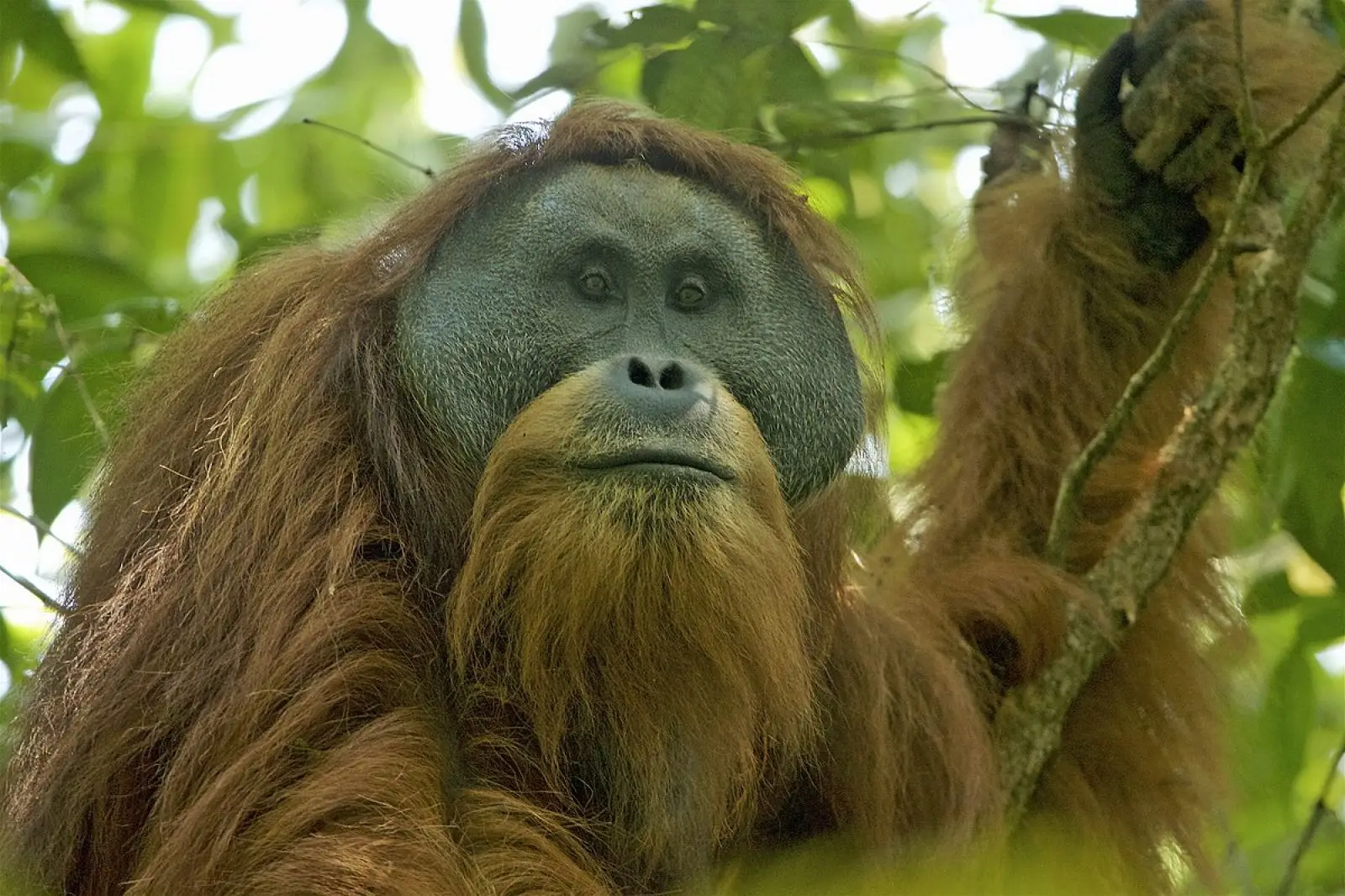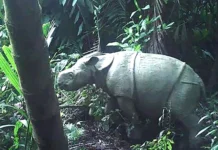The Tapanuli orangutan (Pongo tapanuliensis) is one of the world’s most critically endangered primates, with fewer than 800 individuals left in the wild. This species is native to the remote mountainous regions of northern Sumatra, Indonesia, and was only formally recognized as a distinct species in 2017. Despite being relatively new to the scientific community, the Tapanuli orangutan has become a symbol of the fragility of biodiversity and the urgent need for conservation efforts to protect it from extinction.

A New Species Emerges
For many years, the orangutans of Sumatra were thought to be a single species, the Sumatran orangutan (Pongo abelii). However, after years of genetic and morphological research, scientists discovered that the orangutans found in the Tapanuli region of northern Sumatra were significantly different from the other populations of Sumatran orangutans. These differences led to the classification of the Tapanuli orangutan as a new species in 2017.
The discovery was groundbreaking not only because it revealed a previously unknown species but also because it highlighted the fact that orangutans, which are already critically endangered, are even more vulnerable than previously thought. The Tapanuli orangutan is now recognized as one of the rarest great apes in the world, with its population rapidly declining due to habitat loss, hunting, and other human-induced threats.
Habitat and Distribution
The Tapanuli orangutan is found only in the Batang Toru ecosystem in the Tapanuli region of northern Sumatra, Indonesia. This area is characterized by dense rainforests, rugged mountains, and numerous rivers, providing a rich habitat for the orangutans. The region’s remoteness has helped protect the orangutans to some extent, but human encroachment and development have become significant threats to their survival.
The Tapanuli orangutan’s range is relatively small, and its population is fragmented, with individuals living in isolated pockets within the forest. The fragmentation of their habitat has made it difficult for the orangutans to find mates, leading to inbreeding and further endangering the species. The lack of genetic diversity among the population makes the Tapanuli orangutan even more vulnerable to disease, environmental changes, and other threats.
Physical Characteristics and Behavior
Tapanuli orangutans are physically similar to their Sumatran and Bornean cousins but have distinct differences that set them apart. One of the most noticeable differences is their facial structure. Tapanuli orangutans have a broader, more rounded face compared to other orangutans, and their fur is often lighter in color, ranging from golden to reddish-brown. Males have large cheek pads, which are characteristic of all orangutans, but Tapanuli orangutans tend to have slightly smaller cheek pads than their Sumatran and Bornean counterparts.
In terms of behavior, Tapanuli orangutans exhibit typical orangutan traits such as solitary living, tree-dwelling habits, and a diet consisting mainly of fruit, leaves, and insects. Like other orangutans, Tapanuli orangutans are highly intelligent and have been observed using tools in the wild, such as sticks to extract insects or honey from tree trunks.
Their slow reproductive rate, with females giving birth to a single offspring every 8 to 9 years, makes it difficult for the species to recover from population declines. This low birth rate is a significant factor contributing to the Tapanuli orangutan’s vulnerability to extinction, as the population cannot replace itself quickly enough to withstand the pressures of habitat loss and human activity.
Conservation Status and Threats
The Tapanuli orangutan is classified as critically endangered by the International Union for Conservation of Nature (IUCN), with an estimated population of fewer than 800 individuals. This small population size makes the species highly susceptible to extinction in the wild. The main threats to the survival of the Tapanuli orangutan are habitat loss, illegal logging, palm oil plantations, hunting, and human-wildlife conflict.
One of the biggest threats to the Tapanuli orangutan’s habitat is deforestation. The Batang Toru ecosystem, which is home to the majority of the remaining Tapanuli orangutans, is being cleared for agriculture, particularly for palm oil plantations. Palm oil is a common ingredient in many food products, cosmetics, and biofuels, and its production has led to widespread deforestation in Southeast Asia. As forests are destroyed, orangutans lose their homes, and their chances of survival decrease.
Illegal logging is another significant problem, as trees are felled to make way for infrastructure projects or to supply the timber industry. Roads and other infrastructure projects fragment the orangutans’ habitat, making it more difficult for them to move and find food. The construction of dams and other large-scale projects also threatens the ecosystem by altering water flow and damaging the environment.
Hunting and poaching are also significant threats to the Tapanuli orangutan. Although orangutans are protected by Indonesian law, illegal hunting still occurs, with orangutans being killed for their meat or captured for the illegal pet trade. In some cases, orangutans are killed in retaliation for crop raiding, as they sometimes venture into nearby villages in search of food.
Human-wildlife conflict is a growing concern as more and more people move into the areas surrounding the orangutans’ habitat. As human populations increase, so does the demand for land, which further encroaches on the orangutans’ territory. This often leads to conflict between people and orangutans, with farmers seeing the orangutans as a threat to their crops.
Efforts to Save the Tapanuli Orangutan
Given the critical situation facing the Tapanuli orangutan, a variety of conservation efforts are underway to try and protect the species from extinction. These efforts are being led by a combination of government agencies, conservation organizations, and local communities, with a focus on habitat protection, law enforcement, and community engagement.
One of the key efforts to protect the Tapanuli orangutan is the establishment of protected areas in the Batang Toru region. The Tapanuli orangutan’s habitat is designated as a conservation area, and strict laws are in place to prevent illegal logging and hunting. However, enforcement of these laws remains a challenge, as the remote location of the forest makes it difficult for authorities to monitor and control illegal activities.
Conservation organizations are also working to raise awareness about the Tapanuli orangutan and its plight. By educating local communities, tourists, and the global public about the species, these organizations hope to generate support for conservation efforts and reduce demand for products that contribute to deforestation, such as palm oil. Sustainable palm oil production and responsible consumer choices are critical to the long-term survival of the Tapanuli orangutan.
In addition to habitat protection, efforts are also being made to reduce human-wildlife conflict. Local farmers are being encouraged to adopt more sustainable agricultural practices that do not encroach on orangutan habitats, and alternative sources of income are being explored for communities living near orangutan populations. Ecotourism, for example, has the potential to provide income for local people while also supporting conservation efforts.
The Future of the Tapanuli Orangutan
The future of the Tapanuli orangutan is uncertain. With fewer than 800 individuals left, the species is facing an uphill battle for survival. However, there is hope. Conservation efforts, combined with greater awareness and action from both local and international communities, could help to protect the Tapanuli orangutan and its habitat.
Protecting this critically endangered species will require a concerted effort from all sectors of society. Governments, businesses, conservation organizations, and individuals all have a role to play in ensuring that the Tapanuli orangutan does not become extinct. The Tapanuli orangutan is a symbol of the incredible biodiversity of the world and the need to protect it for future generations.
By supporting sustainable practices, conserving critical habitats, and advocating for the protection of orangutans and other endangered species, we can help secure a future for the Tapanuli orangutan. While the species faces many challenges, it is not too late to make a difference and ensure that this remarkable ape does not vanish from the Earth.





























